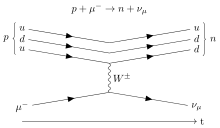Muon capture
Muon capture is the capture of a negative muon by a proton, usually resulting in production of a neutron and a neutrino, and sometimes a gamma photon.

Feynman diagram of the muon capture. A negatively charged muon is captured by a proton. The proton is transformed into a neutron and a muon-neutrino is emitted. The interaction is mediated by a W-boson.
Muon capture by heavy nuclei often leads to emission of particles; most often neutrons, but charged particles can be emitted as well.
Ordinary muon capture (OMC) involves capture of a negative muon from the atomic orbital without emission of a gamma photon:
μ−
+
p+
→
ν
μ +
n0
Radiative muon capture (RMC) is a radiative version of OMC, where a gamma photon is emitted:
μ−
+
p+
→
ν
μ +
n0
+
γ
One motivation for the study of muon capture on the proton is its connection to the proton's induced pseudoscalar form factor gp.
References
- T. Gorringe and H.W. Fearing (2004). "Induced pseudoscalar coupling of the proton weak interaction". Rev. Mod. Phys. 76 (1): 31–91. arXiv:nucl-th/0206039. Bibcode:2003RvMP...76...31G. doi:10.1103/RevModPhys.76.31.
- V.A. Andreev; et al. (2007). "Measurement of the Rate of Muon Capture in Hydrogen Gas and Determination of the Proton's Pseudoscalar Coupling gP". Physical Review Letters. 99 (3): 032002. arXiv:0704.2072. Bibcode:2007PhRvL..99c2002A. doi:10.1103/PhysRevLett.99.032002. PMID 17678281.
This article is issued from Wikipedia. The text is licensed under Creative Commons - Attribution - Sharealike. Additional terms may apply for the media files.